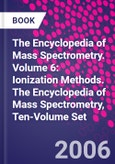Volume 6: Ionization Methods�captures the story of molecular ionization and its phenomenal evolution that makes mass spectrometry the powerful method it is today. Chapters 1 and 2 cover fundamentals and various issues that are common to all ionization (e.g., accurate mass, isotope clusters, and derivatization).
Chapters 3-9 acknowledge that some ionization methods are appropriate for gas-phase molecules and others for molecules that are in the solid or liquid states. Chapters 3-6 cover gas-phase molecules, dividing the subject into: (1) ionization of gas-phase molecules by particles (e.g., EI), (2) ionization by photons, (3) ionization by ion-molecule and molecule-molecule reactions (e.g., APCI and DART), and ionization in Strong electric fields (i.e., Electrohydrodynamic and Field Ionization/Desorption).
"Ionization in a Strong Electric Field" illustrates the transition to ionization of molecules in the solid or liquid states, covered in Chapters 7-9: (1) spray methods for ionization (e.g., electrospray), (2) desorption ionization by particle bombardment (e.g., FAB), and (3) desorption by photons (e.g., MALDI). Electrospray and MALDI also lead to applications in biophysical chemistry, the theme of Chapter 10.
Chapter 11 reconsiders ionization from the view of choosing an ionization method. The range of subjects is from ionization of organic and biomolecules to the study of microorganisms.
Please Note: This is an On Demand product, delivery may take up to 11 working days after payment has been received.
Table of Contents
1. Fundamentals of Ionization2. General Considerations for Ionization
3. Ionization of Gas-Phase Molecules by Particles and at High Temperature: Electron Ionization (EI), Positron Ionization, and Surface Ionization Organic MS
4. Ionization of Gas-Phase Molecules by Photons: Photoionization (PI), Photoelectron Spectroscoy (PES) and Laser Ionization
5. Ionization by Ion-Molecule and Molecule-Molecule Reactions: Chemical Ionization (CI), Atmospheric Pressure Chemical Ionization (APCI), and DART
6. Ionization in Strong Electric Field
7. Spray Methods for Ionization
8. Desorption Ionization by Particle Bombardment: SIMS, Fast Atom Bombardment, and High-Energy Bems
9. Desorption by Photons: Laser Desorption and Matridx-Assisted Laser Desorption Ionization (MALDI)
10. Biophysical Application of Desorption and Spray Ionization
11. Choice of Ionization for Analysis of Various Substances
Authors
Michael L. Gross Washington University, St Louis, USA. Michael L. Gross is Professor of Chemistry and Professor of Medicine at Washington University, St. Louis, as well as Director of the NIH Mass Spectrometry Research Resource located at Washington University.Background, 1966: Ph.D., University of Minnesota 1987: Commonwealth of Massachusetts Pioneer Award, "In Search of the Health Consequences of Dioxin in Our Environment" 1983 -1991: Identified as one of the 50 most cited chemists 1999: Field and Franklin Award of The American Chemical Society 2001: Outstanding Graduate Student Mentor, Washington University Richard Caprioli Vanderbilt University School of Medicine, Nashville, USA. Biography Richard M. Caprioli is the Stanley Cohen Professor of Biochemistry and Director of the Mass Spectrometry Research Center at Vanderbilt University School of Medicine. He is also currently Professor in the Departments of Chemistry and Pharmacology at Vanderbilt.








